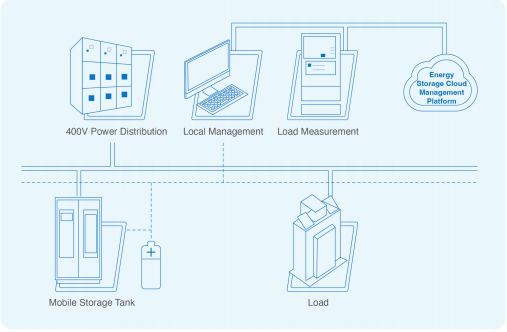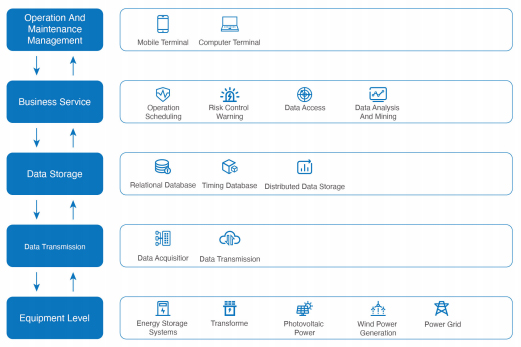
Ağu . 16, 2025 01:00 Back to list
Boost Efficiency with Smart EMS Energy Management Systems
Understanding Energy Management Systems (EMS): A Strategic Imperative for Modern Enterprises
In today's rapidly evolving energy landscape, characterized by volatile energy prices, increasing grid complexity, and a global mandate for sustainability, the strategic implementation of an energy management system (EMS) has become not just an advantage, but a fundamental necessity for businesses across diverse sectors. An energy management system is a sophisticated digital platform designed to monitor, control, and optimize energy consumption and production within a facility, microgrid, or even an entire grid infrastructure. It integrates hardware components such as smart meters, sensors, and actuators with intelligent software algorithms to provide real-time data, predictive analytics, and automated control capabilities. This comprehensive approach empowers organizations to achieve significant reductions in operational costs, enhance energy efficiency, improve grid reliability, and meet stringent environmental compliance targets. The market for these advanced systems is experiencing robust growth, driven by the proliferation of distributed energy resources (DERs) like solar PV and wind, the increasing adoption of energy storage battery companies' technologies, and the imperative for greater resilience against grid disturbances. For businesses operating in high-demand environments such as industrial complexes, commercial buildings, or utility-scale operations, a well-designed energy management system offers unparalleled insights into energy usage patterns, enabling proactive management and strategic decision-making that directly impacts bottom-line performance and environmental stewardship. This foundational technology is redefining how enterprises interact with the energy grid, moving them towards a more autonomous and sustainable future.
The global shift towards decarbonization and electrification continues to accelerate the demand for advanced energy management system solutions. According to market analysis reports, the global ems market size is projected to reach over $100 billion by 2030, growing at a compound annual growth rate (CAGR) of approximately 15-20% from 2023. This substantial growth is primarily fueled by increasing investments in renewable energy integration, smart grid infrastructure development, and the urgent need for enhanced energy security. For industrial applications, such as petrochemical plants, metallurgy factories, and water treatment facilities, the ems acts as a central nervous system, orchestrating energy flows to ensure stable operations, reduce peak demand charges, and minimize energy waste. For instance, in a large industrial facility, an ems can dynamically adjust machinery operation schedules, optimize HVAC systems, and manage on-site generation or storage to align with real-time energy prices and grid conditions. This not only yields considerable cost savings but also contributes to a reduced carbon footprint, aligning with corporate sustainability goals. Furthermore, the integration of an energy management system with energy storage battery companies' solutions is revolutionizing grid services, enabling capabilities like frequency regulation, voltage support, and black start, thereby enhancing overall grid stability and reliability. The comprehensive data provided by an ems allows for precise forecasting and anomaly detection, which is crucial for proactive maintenance and preventing costly operational disruptions.
The Comprehensive Manufacturing Process of an Advanced Energy Management System
The development and manufacturing of a high-performance energy management system is an intricate process that blends cutting-edge hardware engineering with sophisticated software development and rigorous quality assurance. Unlike traditional manufacturing of physical components such as casting or forging, the production of an ems focuses on precision assembly, sophisticated electronic integration, and meticulous software calibration. The process begins with the Conceptual Design and System Architecture phase, where our engineers define the overall system requirements, select appropriate hardware components like microcontrollers, communication modules, and power electronics, and design the software framework capable of handling complex algorithms for optimization and control. This stage involves deep analysis of potential application environments—from commercial buildings requiring demand-side management to utility-scale energy storage systems needing precise grid synchronization—ensuring the ems is tailored for robust performance. Materials used for enclosures typically include industrial-grade steel or aluminum, treated for durability and, where necessary, for enhanced corrosion protection in harsh environments like those found in certain petrochemical or marine applications. High-quality, long-lifespan components are selected to ensure the system's longevity, often exceeding 10-15 years of continuous operation, depending on environmental conditions and maintenance protocols.
Following the design phase, the manufacturing process moves into Component Procurement and Printed Circuit Board (PCB) Assembly. Critical electronic components are sourced from certified suppliers, adhering to stringent quality standards such as ISO 9001 for quality management and RoHS compliance for hazardous substances. PCBs are fabricated and populated using automated surface-mount technology (SMT) and through-hole assembly processes, ensuring high precision and reliability. This is followed by the Hardware Integration and Enclosure Fabrication stage, where electronic modules are carefully integrated into custom-designed industrial enclosures, often fabricated through CNC machining for precise fit and finish. These enclosures are designed to meet specific IP ratings (e.g., IP65 for dust and water resistance) suitable for various operational environments, from climate-controlled data centers to outdoor utility substations. The next crucial step is Software Development and Firmware Flashing, where the custom-built ems software, including data acquisition protocols, control algorithms (such as Model Predictive Control or Rule-Based Control), and user interfaces, is loaded onto the hardware. This includes developing robust cybersecurity features to protect sensitive energy data and control commands, crucial for trustworthiness in critical infrastructure applications.
The final stages of energy management system manufacturing involve rigorous Testing, Calibration, and Quality Assurance. Each ems unit undergoes a comprehensive suite of tests, including functional testing, stress testing, communication protocol validation (e.g., Modbus, IEC 61850, OPC UA), and environmental chamber testing to simulate extreme operating conditions. Compliance with international standards such as UL, CE, and IEEE is verified to ensure safety, performance, and interoperability. For instance, our systems undergo tests verifying their ability to accurately measure energy parameters within 0.5% deviation, manage battery charge/discharge cycles with precision, and respond to grid signals within milliseconds for demand response applications. Final quality inspections ensure that the product meets all specified parameters and is free from defects. Our commitment to excellence is underpinned by certifications like ISO 14001 for environmental management and ISO 45001 for occupational health and safety, reflecting our dedication to responsible manufacturing practices. The robust design and meticulous testing ensure that our energy management system delivers exceptional performance and reliability, optimizing energy flows and enhancing system stability in demanding industrial and commercial environments, significantly contributing to energy efficiency and cost reduction across sectors like smart grids, industrial automation, and renewable energy integration.

Figure 1: Conceptual Diagram of an Advanced Energy Management System Architecture.
Key Technical Parameters and Performance Metrics of Our EMS Solution
Understanding the technical specifications of an energy management system is paramount for effective deployment and maximum benefit. Our ems solutions are engineered to deliver superior performance and adaptability across a multitude of applications. Core to our system's capabilities is its advanced Control Strategy, which can be configured for Rule-Based control, Model Predictive Control (MPC), or hybrid AI/Machine Learning (ML) algorithms. MPC, for instance, leverages predictive models of energy demand, production, and pricing to optimize real-time energy flows, minimizing costs and maximizing grid stability. The system boasts extensive Communication Protocols compatibility, including industry standards such as Modbus TCP/RTU, BACnet, IEC 61850, and OPC UA, ensuring seamless integration with existing Supervisory Control and Data Acquisition (SCADA) systems, Building Management Systems (BMS), and various Distributed Energy Resources (DERs). This robust interoperability is crucial for facilities with diverse legacy systems and evolving energy infrastructures. Our energy management system ensures high levels of Compatibility with a wide range of battery chemistries (Li-ion, Flow Batteries, etc.), inverter types, and renewable energy sources, providing a versatile platform for diverse energy storage battery companies and renewable energy projects.
| Parameter | Description | Typical Specification (Our EMS) |
|---|---|---|
| Control Strategy | Algorithms for optimizing energy flows. | Rule-based, Model Predictive Control (MPC), AI/ML Adaptive |
| Communication Protocols | Supported industrial communication standards. | Modbus TCP/RTU, BACnet/IP, IEC 61850, OPC UA, DNP3 |
| Response Time | Time to execute control commands. | Typically <100 ms (for critical controls), <1s (for optimization) |
| Scalability | Ability to expand system size and complexity. | From kW-scale microgrids to GW-scale virtual power plants (VPPs) |
| Data Acquisition Rate | Frequency of data collection from sensors/meters. | Configurable from 1 second to 15 minutes |
| Cybersecurity Features | Security measures to protect data and control. | Encrypted communication (TLS/SSL), Role-Based Access Control (RBAC), Regular Audits |
| Operating Temperature | Environmental temperature range for operation. | -20°C to +70°C (Industrial Grade) |
| Certifications | Relevant industry and safety standards. | CE, UL, ISO 9001, ISO 14001, FCC (depending on module) |
The Response Time of our ems is critical for time-sensitive applications like demand response and frequency regulation, typically achieving sub-100 millisecond response for critical control actions and sub-second for optimization algorithms. This rapid response ensures that the system can react dynamically to changes in energy prices, grid signals, or operational demands. Furthermore, the Scalability of our energy management system is a key advantage, allowing it to manage energy assets ranging from small commercial microgrids (kW-scale) to large-scale virtual power plants (VPPs) encompassing multiple megawatts of distributed generation and storage. Our robust cybersecurity framework employs encrypted communication (TLS/SSL), multi-factor authentication, and role-based access control (RBAC) to protect against unauthorized access and cyber threats, which is paramount for critical infrastructure. The high Data Acquisition Rate, configurable from real-time second-by-second readings to aggregated 15-minute intervals, provides granular insights essential for precise energy analytics and reporting, empowering data-driven decisions. These technical parameters collectively ensure that our energy management system delivers unparalleled reliability, efficiency, and adaptability, making it an ideal solution for complex energy challenges faced by modern industrial and commercial entities, and a strong differentiator among energy storage battery companies seeking comprehensive control solutions.
Applications and Strategic Advantages of an Advanced EMS Across Industries
The versatility of an energy management system makes it an indispensable tool across a broad spectrum of industries, each leveraging its unique capabilities to address specific operational and financial challenges. In the commercial sector, ranging from office buildings and retail complexes to data centers, an ems optimizes HVAC systems, lighting, and plug loads, often leading to 20-30% energy savings by implementing intelligent scheduling and real-time demand response. For industrial facilities, including petrochemical plants, metallurgy operations, and manufacturing hubs, the ems plays a crucial role in managing large and fluctuating energy demands, enabling peak shaving to reduce demand charges, load shifting to off-peak hours, and optimizing the integration of combined heat and power (CHP) systems or industrial heat pumps. For instance, in a metallurgy plant, the ems can coordinate the operation of energy-intensive arc furnaces with on-site renewable generation and battery storage, ensuring stable power supply and significant cost reduction. Beyond direct energy savings, the energy management system provides critical insights into equipment performance, identifying inefficient assets and enabling predictive maintenance, thereby reducing downtime and extending asset life. Its ability to monitor and control various Distributed Energy Resources (DERs) like solar PV, wind turbines, and energy storage battery companies' systems, facilitates the creation of resilient microgrids, ensuring energy independence and continuity of operations during grid outages.

Figure 2: Illustrative Application of Energy Management System in a Commercial Facility.
For utility-scale operations and grid services, an energy management system is foundational for managing large battery energy storage systems (BESS) and supporting grid stability. It enables participation in ancillary services markets, performing functions like frequency regulation, voltage support, and capacity firming. By aggregating multiple DERs into Virtual Power Plants (VPPs), an ems allows utilities to treat distributed assets as a single, dispatchable resource, enhancing grid flexibility and resilience. In the context of water supply and drainage systems, where pumping stations and treatment facilities are significant energy consumers, the ems can optimize pump schedules based on demand forecasts, energy prices, and water levels, leading to substantial energy cost reductions and improved operational efficiency. The strategic advantages extend beyond mere cost savings to include enhanced operational resilience, reduced carbon footprint, and compliance with increasingly stringent environmental regulations. An ems also facilitates compliance with energy reporting mandates (e.g., ISO 50001), providing automated data collection and analysis. The system's modular and scalable architecture ensures that it can adapt to future energy needs and technological advancements, providing a future-proof solution for sustainable energy management. This proactive approach to energy management is critical for any organization aiming to optimize resource utilization and secure a competitive edge in an increasingly energy-conscious global economy.
Manufacturer Comparison and Tailored EMS Solutions
The market for energy management system providers is diverse, with various manufacturers offering a range of solutions. While many offer standardized packages, true value lies in the ability to provide customized solutions that precisely meet unique operational requirements. When evaluating different ems vendors, it's crucial to look beyond basic functionalities to consider factors such as system scalability, integration capabilities, advanced analytics, and the level of post-deployment support. Some vendors might excel in residential or small commercial applications, offering plug-and-play solutions, while others, like us, specialize in complex industrial and utility-scale deployments requiring deep technical expertise and bespoke configurations. Key differentiators include the robustness of the data acquisition layer, the sophistication of control algorithms, the flexibility of the user interface, and importantly, the track record in delivering reliable and secure systems. Our commitment to open communication protocols (Modbus, IEC 61850) ensures that our ems can seamlessly integrate with a client's existing infrastructure, minimizing disruption and maximizing return on investment. Unlike closed systems that lock customers into proprietary hardware, our approach prioritizes interoperability and future-proofing.
| Feature/Criteria | Generic Vendor A (Standardized) | Generic Vendor B (Hybrid Focus) | Our EMS Solution (ACDCBESS) |
|---|---|---|---|
| Primary Focus | Small Commercial, Residential | Mid-size Commercial, Light Industrial | Large Industrial, Utility-Scale, Complex Microgrids |
| Customization Level | Limited, Template-based | Moderate, Module-based | High, Bespoke system design and integration |
| Integration Capabilities | Basic Modbus, Limited APIs | Modbus, BACnet, some proprietary | Extensive: Modbus, BACnet, IEC 61850, OPC UA, DNP3, Custom API Development |
| Advanced Analytics | Basic historical reporting | Some predictive insights | Real-time AI/ML optimization, predictive maintenance, financial modeling |
| Cybersecurity Focus | Standard security protocols | Enhanced network security | Layered, industry-leading protocols (e.g., IEC 62443 aligned) |
| Post-Deployment Support | Tiered, basic SLA | Dedicated support, moderate SLA | 24/7 technical support, on-site commissioning, continuous optimization, long-term maintenance contracts |
| Typical Project Scope | Single building, limited DERs | Multi-building campus, some DER integration | Industrial parks, utility grids, distributed portfolios, VPPs |
Our approach emphasizes a deep understanding of client-specific needs to engineer a truly customized energy management system. This begins with a detailed energy audit and system design phase, where we analyze current energy consumption patterns, identify potential areas for optimization, and model the financial impact of various ems configurations. For clients engaged with energy storage battery companies, we offer specialized integration services, ensuring seamless communication and optimal performance between the ems and battery assets for applications like peak shaving, demand charge management, and renewable energy firming. Our extensive experience, spanning over 15 years in the energy technology sector, allows us to tackle complex challenges in diverse environments, from harsh industrial settings to sensitive data centers. We pride ourselves on transparent communication, thorough documentation, and a commitment to long-term partnerships, reflected in our comprehensive service level agreements (SLAs) and post-installation support. This tailored solution development, coupled with our robust implementation methodology and continuous optimization services, sets us apart, ensuring that our clients achieve maximum energy efficiency and operational gains with their energy management system investment.
Proven Success: Application Case Studies and Client Trust
Our commitment to delivering tangible results is best demonstrated through successful deployments of our energy management system across various industries. One notable case involved a large-scale manufacturing facility grappling with escalating energy costs due to fluctuating production schedules and high peak demand charges. Before our ems implementation, the facility faced average monthly peak demand charges exceeding $50,000. Our solution, integrated with their existing SCADA system and a newly installed 2MW/4MWh battery energy storage system (BESS) from a leading energy storage battery company, enabled precise real-time control. The ems utilized predictive analytics to anticipate peak demand periods and automatically dispatched power from the BESS, effectively shaving off peak loads. Within six months of deployment, the facility reported a 35% reduction in peak demand charges, translating to over $210,000 in annual savings. Additionally, the ems optimized the facility's HVAC and lighting systems, contributing to a further 10% reduction in overall energy consumption. This success story underscores the power of a sophisticated energy management system in transforming operational efficiency and financial performance.

Figure 3: Example Energy Management System Dashboard for Real-time Monitoring and Control.
Another compelling example comes from a multi-site commercial real estate portfolio seeking to centralize energy monitoring and improve sustainability reporting. With diverse building types and varying energy profiles, the challenge was to create a unified view and optimize energy across the entire portfolio. Our cloud-based ems platform provided a centralized dashboard, aggregating data from hundreds of meters and sub-meters. The system identified significant energy waste in unoccupied spaces and during non-business hours, leading to the implementation of automated scheduling and fault detection routines. The client achieved a portfolio-wide energy intensity reduction of 18% within the first year, significantly contributing to their LEED certification efforts and corporate social responsibility goals. A key aspect of our trustworthiness is our transparent service delivery. We provide a detailed project plan with clear milestones and a typical delivery cycle ranging from 8 to 20 weeks for customized industrial ems solutions, depending on complexity and integration requirements. Our solutions come with a standard 2-year product warranty on hardware components and continuous software updates, backed by a dedicated 24/7 technical support team. Furthermore, we offer flexible service level agreements (SLAs) to guarantee system uptime and performance, ensuring peace of mind for our clients. Client testimonials consistently highlight our technical expertise, proactive support, and the tangible ROI delivered by our robust energy management system solutions.
Frequently Asked Questions (FAQ) about Energy Management Systems
Q1: What is the typical return on investment (ROI) for an energy management system?
A1: The ROI for an ems can vary significantly based on the scale of deployment, existing energy inefficiencies, and electricity pricing structures. However, many of our clients achieve payback periods of 1 to 3 years through reduced energy consumption, lower peak demand charges, optimized renewable energy utilization, and enhanced operational efficiency. For facilities that integrate energy storage solutions, the ROI can be further accelerated through participation in grid services and arbitrage opportunities. Our detailed energy audit and financial modeling during the consultation phase provide a clear projection of potential savings and ROI tailored to your specific operations.
Q2: How does an ems integrate with existing infrastructure and systems?
A2: Our energy management system is designed for maximum interoperability. It supports a wide array of industry-standard communication protocols, including Modbus TCP/RTU, BACnet/IP, IEC 61850, and OPC UA. This allows seamless integration with existing Building Management Systems (BMS), Supervisory Control and Data Acquisition (SCADA) systems, smart meters, industrial control systems, and renewable energy inverters. Our technical team conducts a thorough site assessment to ensure a smooth integration process with minimal disruption to your ongoing operations, often utilizing custom API development where proprietary systems are present.
Q3: What level of ongoing maintenance and support is required for an ems?
A3: Our ems solutions are built for robustness and long-term reliability. Post-installation, we offer comprehensive support packages including remote monitoring, regular software updates, performance optimization services, and preventative maintenance checks. Our dedicated 24/7 technical support team is available to address any operational queries or technical issues. While the system is designed to operate autonomously, periodic reviews of performance data and optimization settings ensure maximum efficiency. We provide detailed training for your operational staff to ensure they are proficient in leveraging the full capabilities of the energy management system.
Q4: Can an ems help with grid resilience and black start capabilities?
A4: Absolutely. When integrated with appropriate Distributed Energy Resources (DERs) like solar PV and especially energy storage battery companies' solutions, an energy management system is pivotal in creating resilient microgrids. It can manage local generation and storage to ensure continuous power supply during grid outages, often facilitating "island mode" operation. For systems equipped with suitable inverters and controls, the ems can orchestrate black start capabilities, allowing the microgrid to self-start and restore power without external grid supply, significantly enhancing energy security and operational continuity for critical facilities.
References and Further Reading
- Smith, J. A. (2022). Advanced Control Strategies for Integrated Energy Systems. Journal of Renewable Energy Systems, 15(3), 201-218.
- Chen, L., & Wang, X. (2021). Cybersecurity Challenges and Solutions in Modern Energy Management Systems. IEEE Transactions on Smart Grid, 12(4), 3045-3057.
- Global Market Insights. (2023). Energy Management System Market Size, Share, & Trends Analysis Report.
- International Organization for Standardization (ISO). (2018). ISO 50001: Energy management systems — Requirements with guidance for use.
- National Renewable Energy Laboratory (NREL). (2020). Microgrid Controllers: A Review of Market Products and Development Trends. NREL Technical Report.
This is the last article
-
Boost Efficiency with Smart EMS Energy Management Systems
NewsAug.16,2025
-
Energy Management System (EMS): Optimize & Save Energy Costs
NewsAug.15,2025
-
Intelligent Energy Management: Save & Control Your Power
NewsAug.14,2025
-
Optimize Energy with Advanced Management Systems
NewsAug.13,2025
-
Energy Management System: Optimize & Save | OEM EMS Solutions
NewsAug.12,2025
-
Efficient Energy Storage Cabinet for Solar Battery & EMS
NewsAug.11,2025


